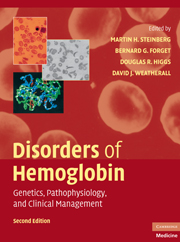Book contents
- Frontmatter
- Contents
- List of Contributors
- Foreword, by H. Franklin Bunn
- Preface
- Introduction, by David J. Weatherall
- SECTION ONE THE MOLECULAR, CELLULAR, AND GENETIC BASIS OF HEMOGLOBIN DISORDERS
- SECTION TWO PATHOPHYSIOLOGY OF HEMOGLOBIN AND ITS DISORDERS
- SECTION THREE α THALASSEMIA
- SECTION FOUR THE β THALASSEMIAS
- SECTION FIVE SICKLE CELL DISEASE
- 19 Clinical and Pathophysiological Aspects of Sickle Cell Anemia
- 20 Sickle Cell Pain: Biology, Etiology, and Treatment
- 21 Hemoglobin SC Disease and Hemoglobin C Disorders
- 22 Sickle Cell Trait
- 23 Other Sickle Hemoglobinopathies
- SECTION SIX OTHER CLINICALLY IMPORTANT DISORDERS OF HEMOGLOBIN
- SECTION SEVEN SPECIAL TOPICS IN HEMOGLOBINOPATHIES
- SECTION EIGHT NEW APPROACHES TO THE TREATMENT OF HEMOGLOBINOPATHIES AND THALASSEMIA
- Index
- Plate section
- References
22 - Sickle Cell Trait
from SECTION FIVE - SICKLE CELL DISEASE
Published online by Cambridge University Press: 03 May 2010
- Frontmatter
- Contents
- List of Contributors
- Foreword, by H. Franklin Bunn
- Preface
- Introduction, by David J. Weatherall
- SECTION ONE THE MOLECULAR, CELLULAR, AND GENETIC BASIS OF HEMOGLOBIN DISORDERS
- SECTION TWO PATHOPHYSIOLOGY OF HEMOGLOBIN AND ITS DISORDERS
- SECTION THREE α THALASSEMIA
- SECTION FOUR THE β THALASSEMIAS
- SECTION FIVE SICKLE CELL DISEASE
- 19 Clinical and Pathophysiological Aspects of Sickle Cell Anemia
- 20 Sickle Cell Pain: Biology, Etiology, and Treatment
- 21 Hemoglobin SC Disease and Hemoglobin C Disorders
- 22 Sickle Cell Trait
- 23 Other Sickle Hemoglobinopathies
- SECTION SIX OTHER CLINICALLY IMPORTANT DISORDERS OF HEMOGLOBIN
- SECTION SEVEN SPECIAL TOPICS IN HEMOGLOBINOPATHIES
- SECTION EIGHT NEW APPROACHES TO THE TREATMENT OF HEMOGLOBINOPATHIES AND THALASSEMIA
- Index
- Plate section
- References
Summary
INTRODUCTION
Parents of children with sickle cell anemia seldom have the same disease as their offspring. In 1927, 17 years after the first clinical description of sickle cell anemia, it was discovered that almost 10% of African Americans had erythrocytes that sickled when deoxygenated. With the subsequent identification of HbS, and the observation that patients with sickle cell anemia had predominantly HbS in their hemolysates, whereas their parents' had both HbS and HbA, the genetics of sickle hemoglobinopathies was characterized and sickle cell trait (HbAS) was defined.
Almost 40 years ago, reports of sudden death in military recruits with HbAS triggered a push for mandatory screening for HbAS, denial of military service for some carriers, and insurance coverage cancellation for others. An astounding list of complications of HbAS appeared in the literature. The interpretation of these reports often disregarded the distinction between statistically significant associations and coincidence, and almost all lacked any control comparisons. This chapter reviews what is known, what is presumed, and what is erroneous about the pathogenicity, clinical features, and management of HbAS.
PATHOGENESIS
HbAS is usually implies simple heterozygosity for the HbS gene (HBB glu6val). Less than half the hemoglobin in the HbAS erythrocyte is HbS; the remainder is mainly HbA. The probability that the mixed hybrid tetramer, α2βSβA, will enter the polymer phase is only half that of the HbS tetramer, α2βS2 (Fig. 22.1A).
- Type
- Chapter
- Information
- Disorders of HemoglobinGenetics, Pathophysiology, and Clinical Management, pp. 549 - 563Publisher: Cambridge University PressPrint publication year: 2009
References
- 1
- Cited by

